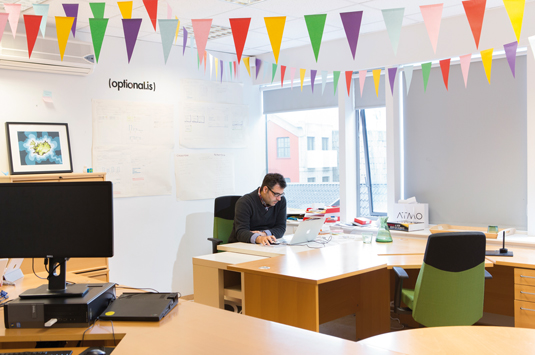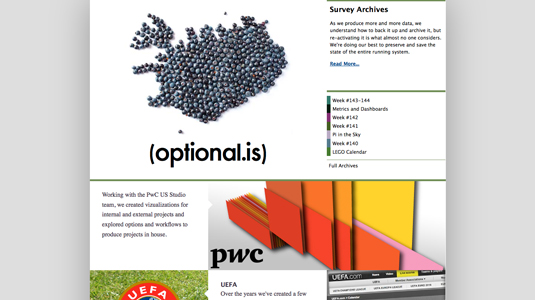Brian Suda on why visualisations need to be beautiful
Data visualisation guru Brian Suda champions a philosophy of intelligent interactive design. He tells Jim Thacker about SVG, determinism – and why ‘informatician’ is a real word.

Brian Suda is a man of many parts. He's American-born, British-educated, but lives and works in Iceland. He's a serious business owner whose clients include government bodies and Fortune 500 companies, yet whose LinkedIn profile lists his interests as "cryptozoology, various coleslaws and sea pirate dialects". And he's a computer scientist whose working life has been devoted to elegant new ways to visualise information. One word for this would be 'polymath'. But Suda has another word for it: 'informatician'.
"My Master's degree is technically in informatics, but no one really knows what that means," he tells .net over a Skype connection from Reykjavik in Iceland. "But if you study mathematics, that makes you a mathematician, so if you study informatics, I figured that must make you an informatician. It became my goal to use the term as much as possible, because if appears often enough in print, you can submit it to the Oxford English Dictionary."
From Saint Louis to Skólapúlsinn
Born and raised in Missouri, Suda studied computer science at Saint Louis University before getting a job with a small local web development firm. Getting itchy feet, and envious of friends who had taken the opportunity to study abroad, he enrolled for that Master's at The University of Edinburgh studying informatics ("computer science at a deeper level: AI and so on," he explains).
On graduation, and unable to stay in the UK without a permanent job, he took a vacation, ending up in Iceland because "it was on the way home". He found work with a large enterprise software company, TM Software, and, liking the country, ended up staying for seven years.
"The whole country only has 300,000 people, and the city of Reykjavik just 120,000. It has that small-town feel," he says. "People are really nice, so you can get integrated very quickly."

From TM Software, Suda moved to CLARA, developing text analytics systems for clients such as CCP, creator of the massively popular science- fiction MMORPG EVE Online; then, encouraged by Iceland's entrepreneurial culture, founded his own company, (optional.is).
"Iceland is an incredibly creative place – and part of that is that there isn't a fear of failure," he says. "It's very easy to start a company, and it's very easy to wind up a company. It isn't a huge embarrassing thing to go out and try."
(Optional.is) does a range of work, from speculative creative projects to data analysis for financial giant PwC. Suda also devotes a lot of his time to his second company, Skólapúlsinn ('school pulse'), which collects psychometric data on grade-school students ("the more touchy-feely abstract concepts: things like bullying, anxiety, student relations, classroom engagement – control over your own life"). But its 'sweet spot' is data visualisation: the speciality for which Suda is best known, through books like A Practical Guide to Designing with Data, and numerous conference talks.

Beauty is not brainless
Visualisation professionals traditionally embrace one of two design philosophies: the 'less is more' approach championed by Edward Tufte, in which any visual element that does not communicate data is scrupulously eliminated; and the skeuomorphic approach of designers like Nigel Holmes, familiar to anyone who has seen a Time or New York Times infographic.
Suda praises Tufte's forensic demonstration of how poor information design led NASA officials to overestimate the safety of the Space Shuttle - with fatal consequences for the crew of the Columbia. But while his own work tends towards the Tufte-ian, he "comes and goes between the two" schools.
"Visualisations need to be beautiful to catch the viewer's eye," he explains. "You don't want black-and-white line graphs the whole time. But at the same time, you should always consider that your audience are intelligent people, and just making smiley faces assumes the customer is ignorant."

The shift from print to online visualisation provides new ways to strike this balance, Suda points out. Rather than simply providing viewers with readymade infographics, an organisation can create interactive tools enabling users to explore the data for themselves.
"For example, PwC produces an annual report showing the gross domestic product of every country in the world. Rather than doing the same visualisations every year, what would happen if we built a tool that had the last 30 years of GDP data?" he asks.
"[PwC] could still do its analysis and write its own narratives, but that tool would become a hub for anyone interested in that information."
Suda believes that the two approaches are not mutually exclusive. Rather than replacing traditional static visualisations, new interactive tools should be seen as complementary to them.
"Take The New York Times. During the [last US Presidential] election, it had some really beautiful interactive graphics, but in order to get there, it probably had to produce some really boring napkin drawings," he notes.
"We've been trying to work with customers not to think only in terms of interactive graphics, but to create something static they can share on Twitter or Facebook along the way, as a teaser to the bigger picture."
This diversification in the format of data visualisations creates a need for professionals with wider skill sets - or at least teams containing a wider variety of professionals.
A lot of designers don't fully understand [mathematical concepts like] statistical significance
"A lot of designers don't fully understand [mathematical concepts like] statistical significance, so they default to more magazine-style layouts," says Suda. "It's the same with web development: frontend development used to be the realm of the graphic designer, but now you have to know JavaScript. Job descriptions are in flux.
"Data visualisation will become more like photography, which can be either a very artsy thing or an incredibly technical discipline," he continues. "There are going to be people who are good at making visualisations look beautiful; there are going to be people who are good at the interactive part; and there are going to be people who are good at finding trends, at data mining. The person who can do all three is going to be rare and sought-after."
Visualisation is print-first
Suda points out that as the need to create visualisations that can be displayed across a variety of media increases, the resolution at which those visualisations should be created becomes an increasingly important technical issue.
"If you're designing for the web, but know that you need to go into print at some point, you need to think at 300dpi," he says. "Designing for the web first, then cutting all your graphs in Photoshop just isn't going to work."
If you're designing for the web, but need to go into print at some point, you need to think at 300dpi
For that reason, Suda favours SVG as a format for online visualisations over alternatives such as the use of the HTML5 canvas element.
"I'm a huge fan of SVG," he says. "It's all vector, and it's all XML, so if you give me an Excel file, I can write a tiny little bit of code that converts it into a bar chart. Once it's in SVG format, I can open it in Illustrator to tweak it. It's a really great workflow: if I'm working with a graphic designer doing layout for print, I can produce something they can use very quickly, since my time isn't wasted measuring bars. And because the result is vectorised, it will print okay."
"There are quite a few tricks and shims to use SVG online now, and even in IE, you can always convert over to VML," he continues. "In the worst case, you can always rasterise the SVG out into a canvas element, or a PNG for older browsers. You might lose some of the interactivity, but older browsers aren't going to be responsive anyway."
Another important issue - and one that still lacks a convenient solution - is the question of interface conventions. While the format in which visualisations are displayed online may be becoming increasingly standardised, the way in which users can interact with them is not.
"People are coming up with new ways to interact with data all the time," Suda comments. "Sometimes you drag on a chart and it highlights the data; sometimes it filters it. Sometimes clicking on a bar will break it into segments; sometimes it does something else. No one is really sure what the expectation is when a user does something."
"Google Analytics is a good example," he continues. "When you log in, you get a line graph of visits to your site over a certain period of time, but when you click on that line it's, 'Oh, do you want to add an annotation here?' Well, no, I don't: I want to zoom in on a particular week. Other sites will let me do that, but in Analytics, you have to use the data picker widget."
Dopplr, determinism & digression
Outside of pure visualisation, one of Suda's current interests is deterministic design, which is the use of mathematical analysis to determine and create design parameters.
"Coming from a computer science background, deterministic design is very interesting to me," he says. "They say that a good programmer is a lazy programmer: once I've written some code, I don't want to have to think about the design in future - I want to feed in new numbers, and get something out the other end."
"Some of my favourite deterministic design is very simple," he continues. "The old Dopplr site did this well. It had over 100,000 cities to display, and there was no way the team was going to go through and assign a colour to each one by hand, so they used a deterministic algorithm [to assign a colour based on the text string for the name of the city]: not necessarily a unique one, but one that could represent that string consistently."
The (optional.is) website uses the same principles to generate accent colours for the different categories. "I really enjoy colours, but I'm not very good at picking or designing with them, so I surrendered to the algorithm," laughs Suda.

It seems an appropriately playful solution for site on which reports on recent jobs sit alongside erudite rants about, for example, the design of the office taps (what initially seems a digression quickly develops into a Donald Norman-eque plea for user-centred design).
Suda says that he draws little distinction between 'commercial' and 'creative' work. "A lot of things start out as side projects but slowly blossom into things we can sell," he says. "One afternoon, we took some time out to play with vision tracking, and even in half a day, we got pretty far with having the webcam follow people and draw a trail behind them. We're looking now at packaging this up for data visualisation projects so that as real people walk down the street, numbers come up behind them.
"It's a perfect example of when having free time to play around can turn into something we can show off in a wider context."
Payment strictly optional?
This refusal to separate work and play seems very much in keeping with the creative spirit of Iceland: a country in which "it seems like every other person you meet has a band, has made a CD and has probably written a book of poetry".
But while blending play and professionalism has helped Suda integrate into his adopted homeland, has led to him becoming one of the most influential voices on interactive design - and may yet lead to the word 'informatician' becoming an official part of the English language - it has also sometimes had unforeseen consequences: the need to add the final '.is' to the name of his company being one of them.
"When you register a copy of QuickTime, it asks you to type in your name and serial number, but the Company field was always marked as '(optional). So to be passive-aggressive, I originally decided to call the company that, complete with the brackets, to see if QuickTime would accept it. It was just one of these haha, funny things - until I sent out the first invoice, and realised that it had (optional) written on top in huge letters!
This article originally appeared in net magazine issue 246.
Liked this? Read these!
- How to build an app: try these great tutorials
- Brilliant Wordpress tutorial selection
- Check out these incredible JavaScript examples

Thank you for reading 5 articles this month* Join now for unlimited access
Enjoy your first month for just £1 / $1 / €1
*Read 5 free articles per month without a subscription

Join now for unlimited access
Try first month for just £1 / $1 / €1
Get the Creative Bloq Newsletter
Daily design news, reviews, how-tos and more, as picked by the editors.

The Creative Bloq team is made up of a group of art and design enthusiasts, and has changed and evolved since Creative Bloq began back in 2012. The current website team consists of eight full-time members of staff: Editor Georgia Coggan, Deputy Editor Rosie Hilder, Ecommerce Editor Beren Neale, Senior News Editor Daniel Piper, Editor, Digital Art and 3D Ian Dean, Tech Reviews Editor Erlingur Einarsson, Ecommerce Writer Beth Nicholls and Staff Writer Natalie Fear, as well as a roster of freelancers from around the world. The ImagineFX magazine team also pitch in, ensuring that content from leading digital art publication ImagineFX is represented on Creative Bloq.
